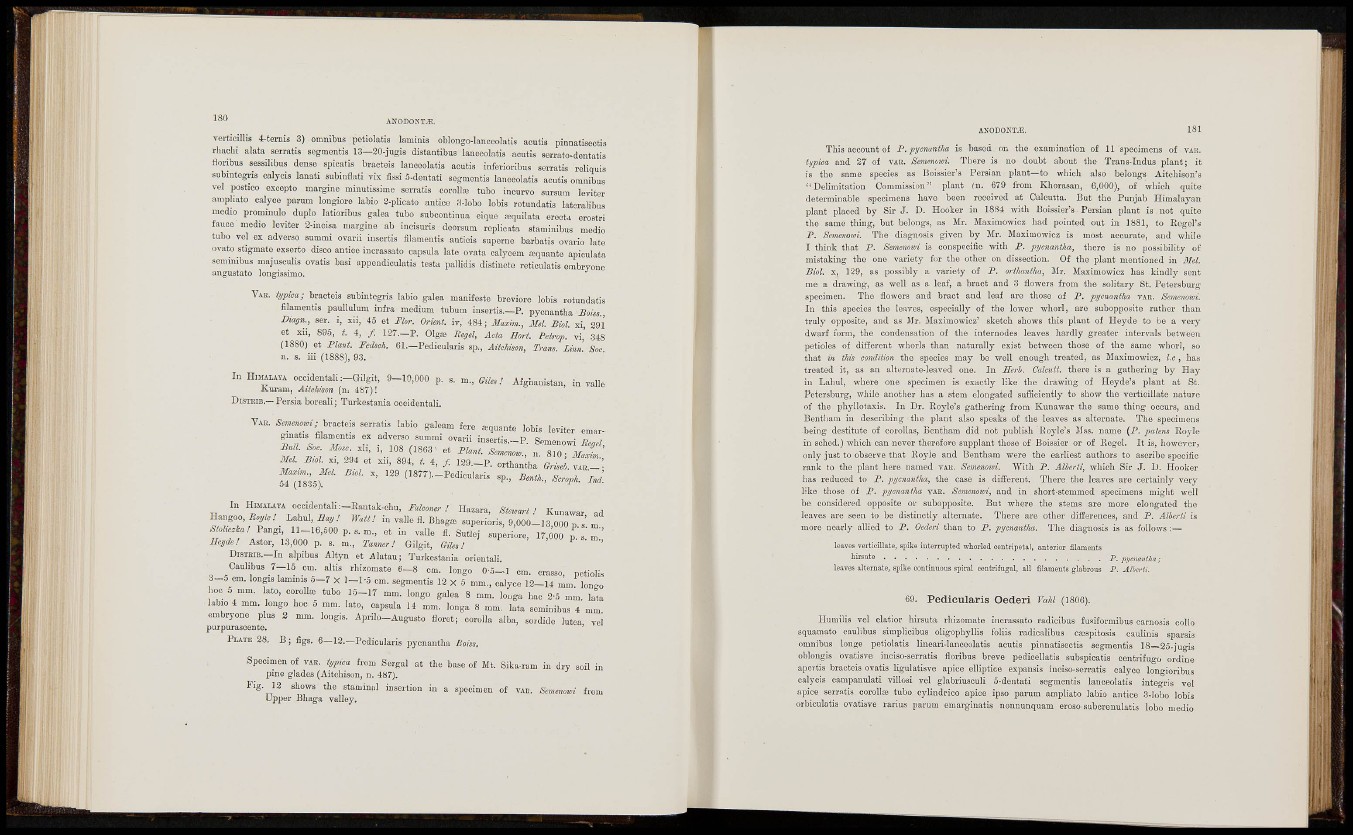
vertieillis 4-ternÌ3 3) omnibus pctioiatis laminis oblougo-ianceolatis aeutia pinnatiaectis
thachi alata somtis SBgmontis 13—20-jugis distanlibas lanceoktis acutis scrrato-dsntatis
floribas sessOibas dense spicatis bractois lanceolatis aoalis infevioribus sorratis reliquia
submtegrà calycia lanati subinflati yix fiaai D-dentati sogmentis lancaolatis aculis oninibaa
Tel poahco oicopto margino minutiasime aerrslis corolla! tubo inonrYO sarsuin loTiter
ampliato calyce parum longioro iabio 2-pIioato antico S-lobo lobis rotundatis lataralibua
medio prominnlo duplo latioribus galea tabo subcontinua eiqao ajquilala erocta aro.tri
iauce medio leriter 3-incisa margine ab incisims deoranm replicata staminibua inodio
tubo TOl ex adyerso summi OTarii insertis filamentis autioia superne barbatia ovario late
ovato stigmate ezserto diaco antice incrassato capsula late ovata calyeem jequante apicnlata
semimbns majuscalis ovatis baai appendieulati. testa pallidis diatincto retieulatis embryone
aiigustato I on gissimo.
VAR. typica; bracteis subintegris lablo galea manifeste breviore lobis rotundatis
filamentis paullulum infra medium tubum insertis.—P. pycnantha Boiss
Diagn., ser. i, xii, 45 et Fior. Orimi, iv, 484; Maxm., Mel. Biol, xi 291
et xii, 895, i. 4, /. 127.-P. 01g£e Kegel, Acta Eort. Peirop. TÌ 348
(1880) et Plant Fedsck. 6I.-Pedicularis sp., Aitchison, Trans. Linn. Soc
, In IIiMALAYA occidentali :—Gi!git, 9—10,000 p. Giles! Afghanistan, in ralle
Kuram, Aitchison (n. 487)!
DISTEIB.— Persia boreali ; Turkestania occidentali.
VAS. bracteis serrat.s laWo galeam fere »quante lobia leviter cmargmatis
filamentis ei adverso aammi ovarii insertis._P Semenowi B™,/
Bull. So,. xli, i, 108 (1863- et Mant n 8
f '' ^
In IlrMAiATA occidentali:-Eantak.elia, Ha . a r a , Stuart! Kunawar ad
Hangoo iì,,/«/^ in valle fi. Bhaga, superioris, 9.000-13,000 ™s. ^
11 16,500 P.S. n,., et in valle fi. Satlej superiore, 17,^00 jL. m '
I/ande.r Astor, 13,000 p. s. m., Jiimer.' Gilgit, Gäe,.' p. a. m,,
DiSTSiB.-In alpibas Altyn et Alatau; Turkestania orientali.
Caalibus 7 -15 cm. altis ihi»mate 6 - 8 cm. longo Oò-l cm. crasso, petiolis
3 - 5 cm. longis kmmi a 5 - 7 X 1 - 1 - 5 cm. aegmentia 12 X 5 mm., calyce 12-14 mn, lon™
hoc 5 mm. lato, ooroUa, tubo 15-17 mm. longo galea 8 mm. looga bao 2-5 mm. lai
lab.o 4 mm. longo hoc 5 mm. lato, capsula 14 mm. longa 8 mm. lata aeminibas 4 mm
embryonc plus 2 mm. longìa. Aprdo-Augnato florct; corolla alba, sordide lutea ve!
pul'puraacente. '
PLATE 28. B; figs. 6-12.-Pedicu!aris pycnantha Bom,
Specimen of YAK. ¿¿/^im from Sergal at the base of Mfc. Sika-rum in dry soil in
pine glades (Aitchisun, n. 487).
Fig. 12 Shows the stauiinal insertion in a specimen of VAE. ¿'menom from
Uppor Bhaga Valley.
AKODOKT^. 181
This account of F. pycnantha is based on the examination of 11 specimens of VAK.
tijpica and 27 of VAE. Semenowi. There is no doubt about the Trans-Indus plant; it
is the same species as Boissier's Persian plant—to which also belongs Aitchisou's
"Delimitation Commission" plant In. 679 from Khorasan, 6,000), of which quite
determinable specimens have been received at Calcutta. But the Punjab Himalayan
plant placed by Sir J. D. Hooker in 1884 with Boissier's Persian plant is not quite
the same thing, but belongs, as Mr. Maximowicz had pointed out in 1881, to Kegel's
P . Semenowi. The diagnosis given by Mr. Maximowicz is most accurate, and while
I tliink that F. Semenowi is conspecific with F. pjjcnantha, thero is no possibility of
mistaking the one variety for the other on dissection. Of the plant mentioned in Mel.
Biol. X, 129, as possibly a variety of P. orihantha, Mr. Maximowicz has kindly sent
me a drawing, as well as a leaf, a bract and 3 flowers from the solitary St. Petersburg
specimen. The flowers and bract and leaf are those of F. pycnantha VAR. Semenowi.
In this specics the leaves, especially of the lower whorl, are subopposite rather than
truly opposite, and as Mr. Maximowicz' sketch shows this plant of Heyde to be a very
dwarf form, the condensation of the internodes leaves hardly greater intervals between
petioles of difierent wliorls than naturally exist between those of tha same whorl, so
that in this condition the species may be well enough treated, as Maximowicz, l.c , has
treated it, as an alternate-leaved one. In Jlerb. Calcutt. there is a gathering by Hay
in Lahul, where one specimen is exactly like the drawing of Heyde's plant at St.
Petersburg, while another has a stem elongated sufficiently to show the verticillate nature
of the phyllotaxis. In Dr. Royle's gathering from Kunawar the same thing occurs, and
Bentliam in describing the plant also speaks of the leaves as alternate. The specimens
being destitute of corollas, Bentham did not publish Royle's Mss. name (P. patens Royle
in sched.) which can never therefore supplant those of Boissier or of Kegel. It is, however,
only just to observe that Hoyle and Bentham were the earliest authors to ascribe specific
rank to the plant here named VAII. Semenowi. "With P. Alhedi, which Sir J. D. Hooker
has reduced to P. pycnantha, the case is different. There the loaves are certainly very
like those of P. pycnantha VAR. Semenowi, and in short-stemmed specimens might well
be considered opposite or subopposite. But where the stems are more elongated the
leaves are seen to be distinctly alternate. There are other difEerences, and P. Alberti is
more nearly allied to P. Oederi than to P. pycnantha. The diagnosis is as follows ; —
leaves Tertioillate, spika interrupted wkorled centripetal, anterior filaments
^»«»t® P. pycnantha ;
leaves alternate, spiko oontinuous spiral centrifugal, all filaments glabrous P. Alberti.
69. Pedicularis Oederi Vahl (1806).
Humilis vel elatior hirsuta rhizomate incrassato radicibus fusiformibus carnosis collo
squamato caulibus simplicibus oligophyllis foliis radicalibus caispitosis caulinis sparsis
omnibus longe petiolatis lineari-lanceolatis acutis piniiatisectis segmentis 18—25-jugis
oblongis ovatisve inciso-serratis floribus breve pedicellatis subspicatis centrifugo ordine
apevtis bracteis ovatis ligulatisve apice elliptice expansis inciso-serratis calyce longioribus
calycis campanulati villosi vel glabriusculi 5-dentati segmentis lanceolatis integris vel
apice serrfltis corollas tnbo cylindrico apice ipso parum ampliato labio antice 3-lobo lobis
orbiculatis ovatisve rarius parum emarginatis nonnuaquam eroso-subcreuulatis lobo medio
ilitt